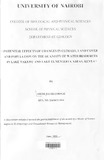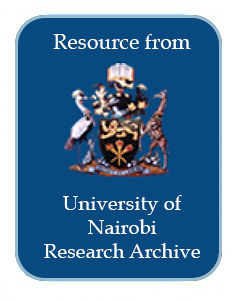Location
Our Vision is to be a world-class university committed to scholarly excellence.
Our Mission is to provide quality university education and training and to embody the aspirations of the Kenyan people and the global community through creation, preservation, integration, transmission and utilization of knowledge.
Core Values
In order to realize the above vision and mission, certain shared values shall be nurtured. There is great need for the University to be guided by the right values derived from the virtues and moral standards of the Kenyan and wider society.
Core Functions
Teaching and Learning: The university offers innovative , relevant and market driven academic programmes , both at undergraduate and postgraduate levels with inbuilt quality control systems the university also provides an environment and policy framework for undertaking high quality and relevant research
Members:
Resources
Displaying 111 - 115 of 298Impact of land use and cover change on soil quality And pasture productivity in semi-arid rangelands: the Case of Nakasongola district, Uganda
The impact of land use and cover change on soil quality and pasture production was investigated in the rangelands of Nakasongola District, Uganda. Landsat (TM) images of 1986 and 1990 and Landsat (ETM+) of 2000 and 2004 for Nakasongola District were used to determine the extent and patterns of land use and cover change using the Integrated Land and Water Information Systems (ILWIS) 3.6 software.
Different land use types in the semi-arid rangelands of Kenya influence soil properties
Rangelands in semi-arid Kenya have recently witnessed extensive land use changes. These changes can mainly be attributed to increased livestock populations and the response of the increased human population to both local and exogenous opportunities and constraints. This study was carried out in Kibwezi district of Kenya mainly inhabited by agro-pastoralists. The main objective of this study was to establish how different land use types influence soil properties in tropical semi-arid rangelands.
Potential effects of changes in climate, land cover and population on the quantity of ater resources in lake nakuru and lake elmenteita areas, kenya
This study evaluates the potential effects of changes in climate, population and land cover on the
quantity of surface water and groundwater resources in Lake Nakuru and Lake Elmenteita areas.
Multiple linear regression analysis of the variables was done using Statistical Package for Social
Sciences (SPSS) to achieve this objective. Population grows in the area at the rate of 3.4% to
4.5% while natural vegetation cover is diminishing at 2.5% annually. There is constant rise in
Pathways to Real Access to Land-Related Resources for Women: Challenging and Overturning Dominant Legal Paradigms
Farmers' ethno-ecological knowledge of the termite problem in semi-arid Nakasongola
Infestation and destruction of rangeland vegetation by subterranean termites is a major constraint to livestock production in the rangelands of Uganda, particularly, in semi-arid Nakasongola. Ethno¬ecological studies on termite dynamics are central to formulation of sustainable termite management strategies in such ecosystems. This study was thus conducted to investigate farmers' traditional ecological knowledge of the termite problem with the intent to build more coherent principles required in the development of appropriate termite management strategies.






